Analysis of the Operation of Cascade Current Transformers for Measurements of Short-Circuit Currents with a Non-Periodic Component with a Large Time Constant of Its Decay
Abstract
:1. Introduction
2. Construction of Cascade Current Transformers for Measuring Short-Circuit Currents
- rated insulation voltage: 30 kV;
- primary rated current: 50 kA;
- rated secondary current: 5 A;
- rated power: 20 VA;
- accuracy class: 0.2;
- decay time constant of the non-periodic component of the short-circuit current;
- Tp = 200 ms;
- continuous operation: up to 20 kA.
3. Mathematical Model of the Current Transformer
4. The Results of the Calculations and Tests
5. Conclusions
Author Contributions
Funding
Institutional Review Board Statement
Informed Consent Statement
Data Availability Statement
Conflicts of Interest
References
- IEC/EN 61869-1; Instrument Transformers—Part 1: General Requirements. Electrotechnical Commission: Geneva, Switzerland, 2009.
- IEC/EN 61869-2; Instrument Transformers—Part 2: Additional Requirements for Current Transformers. Electrotechnical Commission: Geneva, Switzerland, 2013.
- Torre, F.D.; Faifer, M.; Morando, A.P.; Ottoboni, R.; Che, C. Instrument transformers: A different approach to their modeling. IEEE Int. Workshop Appl. Meas. Power Syst. AMPS 2011, 37–42. [Google Scholar] [CrossRef]
- Chen, Y.; Huang, Z.; Duan, Z.; Fu, P.; Zhou, G.; Luo, L. A four-winding inductive filtering transformer to enhance power quality in a high-voltage distribution network supplying nonlinear loads. Energies 2019, 12, 2021. [Google Scholar] [CrossRef] [Green Version]
- Leal, A.C.; Trujillo, C.; Piedrahita, F.S. Comparative of power calculation methods for single-phase systems under sinusoidal and non-sinusoidal operation. Energies 2020, 13, 4322. [Google Scholar] [CrossRef]
- Szewczyk, M.; Kutorasinski, K.; Pawlowski, J.; Piasecki, W.; Florkowski, M. Advanced modeling of magnetic cores for damping of high-frequency power system transients. IEEE Trans. Power Deliv. 2016, 31, 2431–2439. [Google Scholar] [CrossRef]
- Das, N.; Kazimierczuk, M.K. An overview of technical challenges in the design of current transformers. In Proceedings of the Electrical Insulation Conference and Electrical Manufacturing Expo; Indianapolis, IN, USA, 2005; pp. 369–377. [Google Scholar] [CrossRef]
- Faifer, M.; Laurano, C.; Ottoboni, R.; Toscani, S.; Zanoni, M. Harmonic distortion compensation in voltage transformers for improved power quality measurements. IEEE Trans. Instrum. Meas. 2019, 68, 3823–3830. [Google Scholar] [CrossRef]
- Pan, J.; Vu, K.; Hu, Y. An efficient compensation algorithm for current transformer saturation effects. IEEE Trans. Power Deliv. 2004, 19, 1623–1628. [Google Scholar] [CrossRef]
- El-amin, M.; Al-abbas, N.H. Saturation of current transformers and its impact on digital overcurrent relays. In Proceedings of the IEEE/PES Transmission & Distribution Conference and Exposition: Latin America, Caracas, Venezuela, 15–18 August 2006; pp. 1–6. [Google Scholar] [CrossRef]
- Jian-Dong, D.; Yang, L.; Zhuan-Ting, J.; Hao, L.; Qing, Z.X.; Yang, Z.Y. Empirical analysis on transient saturation characteristic of current transformer. In Proceedings of the IEEE Transportation Electrification Conference and Expo., Asia-Pacific (ITEC Asia-Pacific), Harbin, China, 7–10 August 2017; pp. 1–6. [Google Scholar] [CrossRef]
- Stachel, P.; Schegner, P. Detection and correction of current transformer saturation effects in secondary current signals. In Proceedings of the IEEE Power & Energy Society General Meeting, Calgary, AL, Canada, 26–30 July 2009; pp. 1–6. [Google Scholar] [CrossRef]
- Olak, J.; Przybysz, J. Current Converter for Simultaneous Transformation of High and Low Short-Circuit Currents in the High Voltage. Range. Patent P.419126, 13 October 2016. (In Polish). [Google Scholar]
- Olak, J.; Olak, A. Medium Voltage Current. Transformer. Patent PL 203053 B1, 11 August 2009. (In Polish). [Google Scholar]
- Babiuch, M.; Olak, J. The system of measurement of symmetrical and asymmetric short circuit current with multi range current transformers in conditions of short-circuit testing laboratory. Politechnika Gdańska 2019, 159–162. [Google Scholar] [CrossRef]
- Irani, Y.; Lapthorn, A.; Bodger, P. Equivalent circuit model of cascade connected partial core resonant transformers. In Proceedings of the Australasian Universities Power Engineering Conference, Hobart, TAS, Australia, 29 September–3 October 2013; p. 4. [Google Scholar] [CrossRef] [Green Version]
- Dash, A.R.; Panda, A.K.; Patel, R.; Penthia, T. Design and implementation of a cascaded transformer coupled multilevel inverter-based shunt active filter under different grid voltage conditions. Inter. Trans. Syst. Elektr. 2018, 29, 20. [Google Scholar] [CrossRef]
- Johnston, D.L.; Lucas, H.R. 735-kV cascade style current transformer. IEEE Trans. Power App. Syst. 1967, 86, 1205–1209. [Google Scholar] [CrossRef]
- Zhurakhivskyi, A.V.; Kens, Y.A.; Ravlyk, R.O.M.; Ferensovych, Y. Investigation of emergency modes of cascade current transformers after disconnection their secondary circuits. Tech. Electrodyn. 2018, 1, 78–86. [Google Scholar] [CrossRef]
- Koszmider, A.; Olak, J.; Piotrowski, Z. Current Transformers; WNT: Warszawa, Poland, 1985; pp. 1–283. ISBN 8320407109. (In Polish) [Google Scholar]
- Przybysz, J.; Olak, J.; Piątek, Z. Universal current transformer for accurate measurement of short-circuit currents. Acta Energetica 2017, 1, 101–106. [Google Scholar] [CrossRef]
- Amoiralis, E.I.; Georgilakis, P.S.; Tsili, M.A.; Kladas, A.G. Global transformer optimization method using evolutionary design and numerical field computation. IEEE Trans. Magn. 2009, 45, 1720–1723. [Google Scholar] [CrossRef]
- Lesniewska, E. Applications of the field analysis during design process of instrument transformers. In Transformers. Analysis, Design, and Measurement; Lopez-Fernandez, X.M., Ertan, B.H., Turowski, J., Eds.; CRC Press Taylor & Francis Group: Boca Raton, FL, USA; London, UK; New York, NY, USA, 2012; pp. 349–380. [Google Scholar]
- Dems, M.; Komeza, K. Designing an energy-wide frequency range. IEEE Trans. Ind. Electron. 2021, 69, 4387–4397. [Google Scholar] [CrossRef]
- Lesniewska, E.; Jalmuzny, W. The estimation of metrological characteristics of instrument transformers in rated and overcurrent conditions based on the analysis of electromagnetic field. Int. J. Comput. Math. Electr. Electron. Eng. 1992, 11, 209–912. [Google Scholar] [CrossRef]
- Asghari, B.; Dinavahi, V.; Rioual, M.; Martinez, J.A.; Iravani, R. Interfacing techniques for electromagnetic field and circuit simulation programs IEEE task force on interfacing techniques for simulation tools. IEEE Trans. Power Deliv. 2009, 24, 939–950. [Google Scholar] [CrossRef]
- Lesniewska, E.; Rajchert, R. Application of the field-circuit method for the computation of measurement properties of current transformers with cores consisting of different magnetic materials. IEEE Trans. Magn. 2010, 46, 3778–3782. [Google Scholar] [CrossRef]
- Lesniewska, E. Influence of the selection of the core shape and winding arrangement on the accuracy of current transformers with through-going primary cable. Energies 2021, 14, 1932. [Google Scholar] [CrossRef]
- Kumbhar, G.B.; Mahajan, S.M. Analysis of short circuit and inrush transients in a current transformer using a field-circuit coupled FE formulation. Int. J. Electr. Power Energy Syst. 2011, 33, 1361–1367. [Google Scholar] [CrossRef]
- Lesniewska, E.; Jalmuzny, W. Influence of the number of core air gaps on transient state parameters of TPZ class protective current transformers. IET Sci. Meas. Technol. 2009, 3, 105–112. [Google Scholar] [CrossRef]
- Afonso, J.I.; Toscano, P.; Briozzo, I. Current transformer modeling for electromagnetic transient simulation in protection systems. In Proceedings of the IEEE PES Transmission & Distribution Conference and Exhibition—Latin America, Montevideo, Uruguay, 28 September–2 October 2020; pp. 1–6. [Google Scholar] [CrossRef]
- Li, C.; Li, Q.; Yao, J.; Liu, M. The characteristics of electromagnetic current transformers with DC bias. In Proceedings of the International Conference on Sustainable Power Generation and Supply, Nanjing, China, 6–7 April 2009; pp. 1–6. [Google Scholar] [CrossRef]
- Diez, P.; Webb, J.P. A rational approach to B-H curve representation. IEEE Trans. Magn. 2016, 52, 7203604. [Google Scholar] [CrossRef]
- Trutt, F.C.; Erdelyi, E.A.; Hopkins, R.E. Representation of the magnetization characteristic of DC machines for computer use. IEEE Trans. Power Appar. Syst. 1968, 87, 665–669. [Google Scholar] [CrossRef]
- Markovic, M.; Perriard, Y.E. Current power losses in a toroidal laminated core with rectangular cross section. In Proceedings of the 12th International Conference on Electrical Machines and Systems, Tokyo, Japan, 15–18 November 2009; pp. 1–4. [Google Scholar]
- Poveda-Lerma, A.; Serrano-Callergues, G.; Riera-Guasp, M.; Pineda-Sanchez, M.; Puche-Panadero, R.; Perez-Cruz, J. 3D simulation of a power transformer considering lamination effects. In Proceedings of the 18th International Symposium on Electromagnetic Fields in Mechatronics, Electrical and Electronic Engineering (ISEF) Book of Abstracts, Lodz, Poland, 14–16 September 2017; pp. 1–2. [Google Scholar] [CrossRef]
- Kefalas, T.D.; Georgilakis, P.S.; Kladas, A.G.; Souflaris, A.T.; Paparigas, D.G. Multiple grade lamination wound core a novel technique for transformer iron loss minimization using simulated annealing with restarts and an anisotropy model. IEEE Trans. Magn. 2008, 44, 1082–1085. [Google Scholar] [CrossRef] [Green Version]
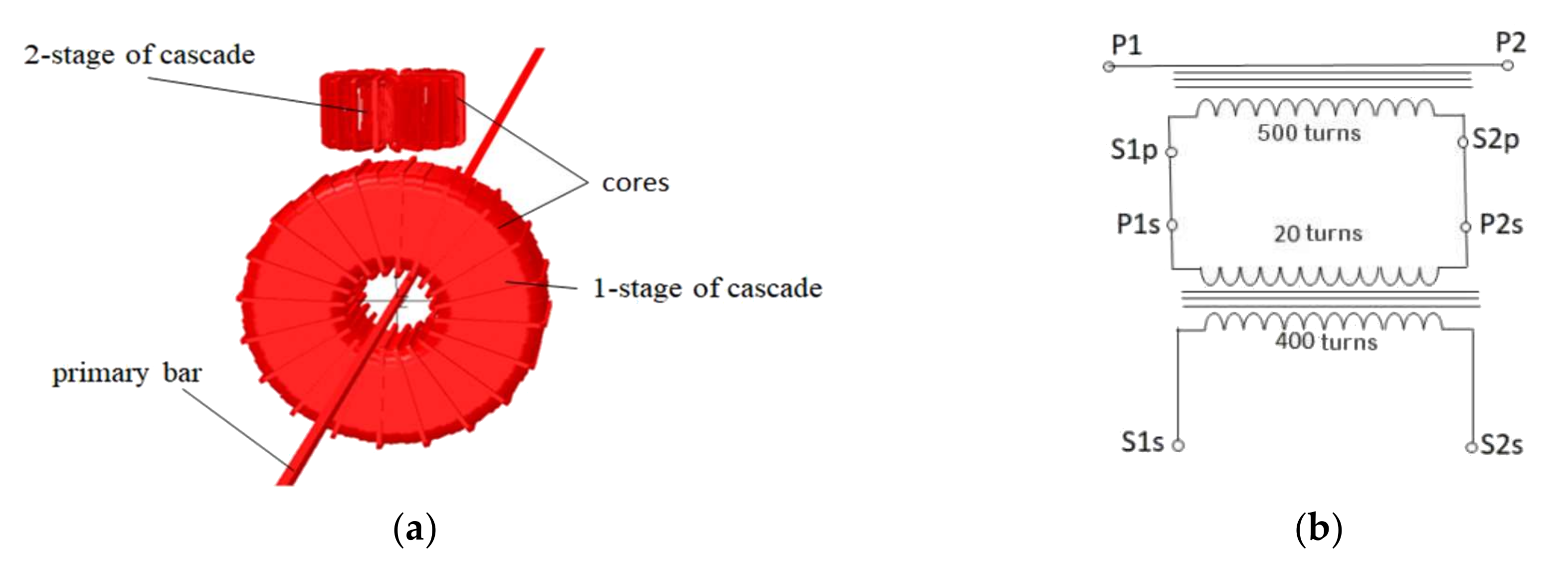


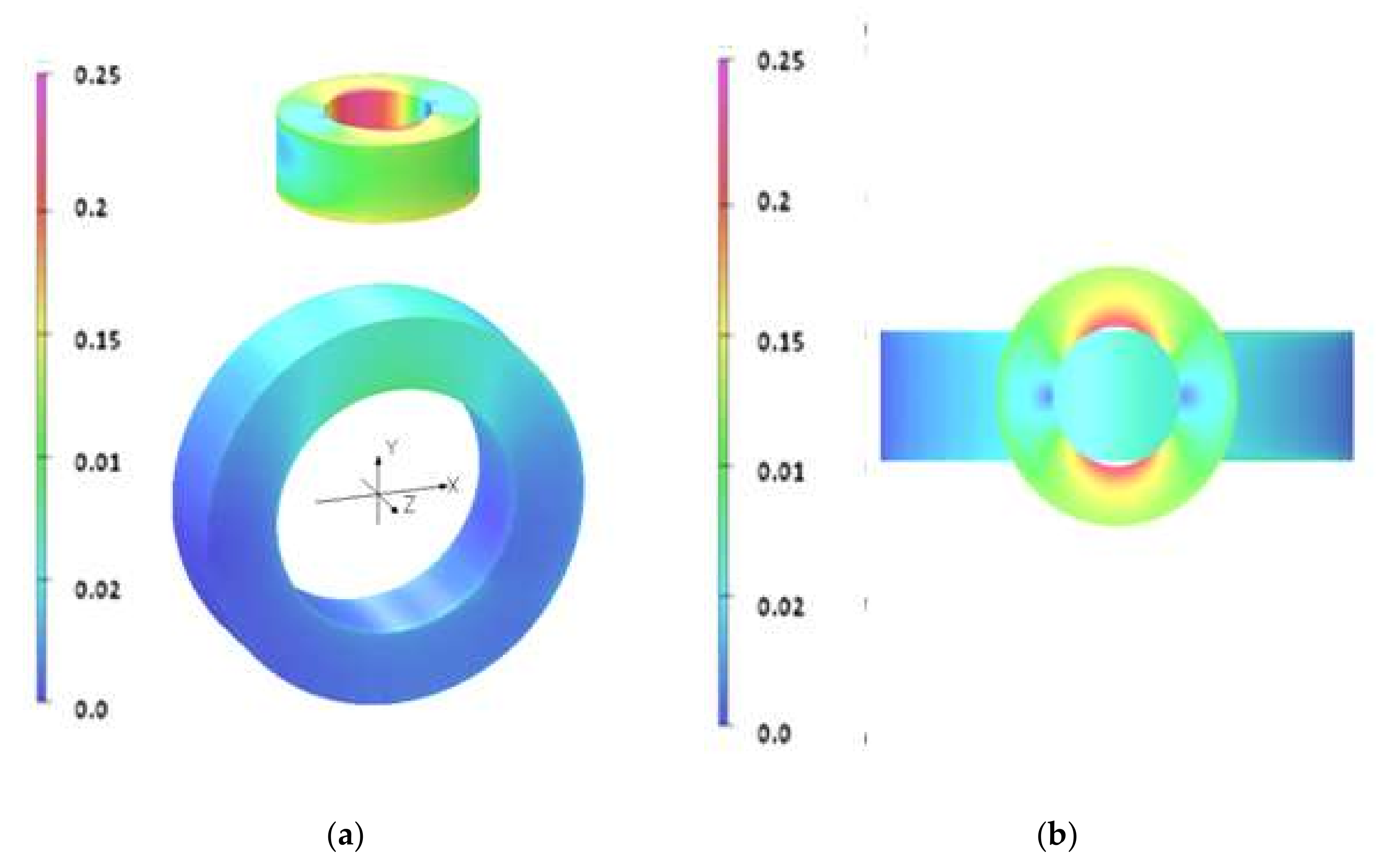

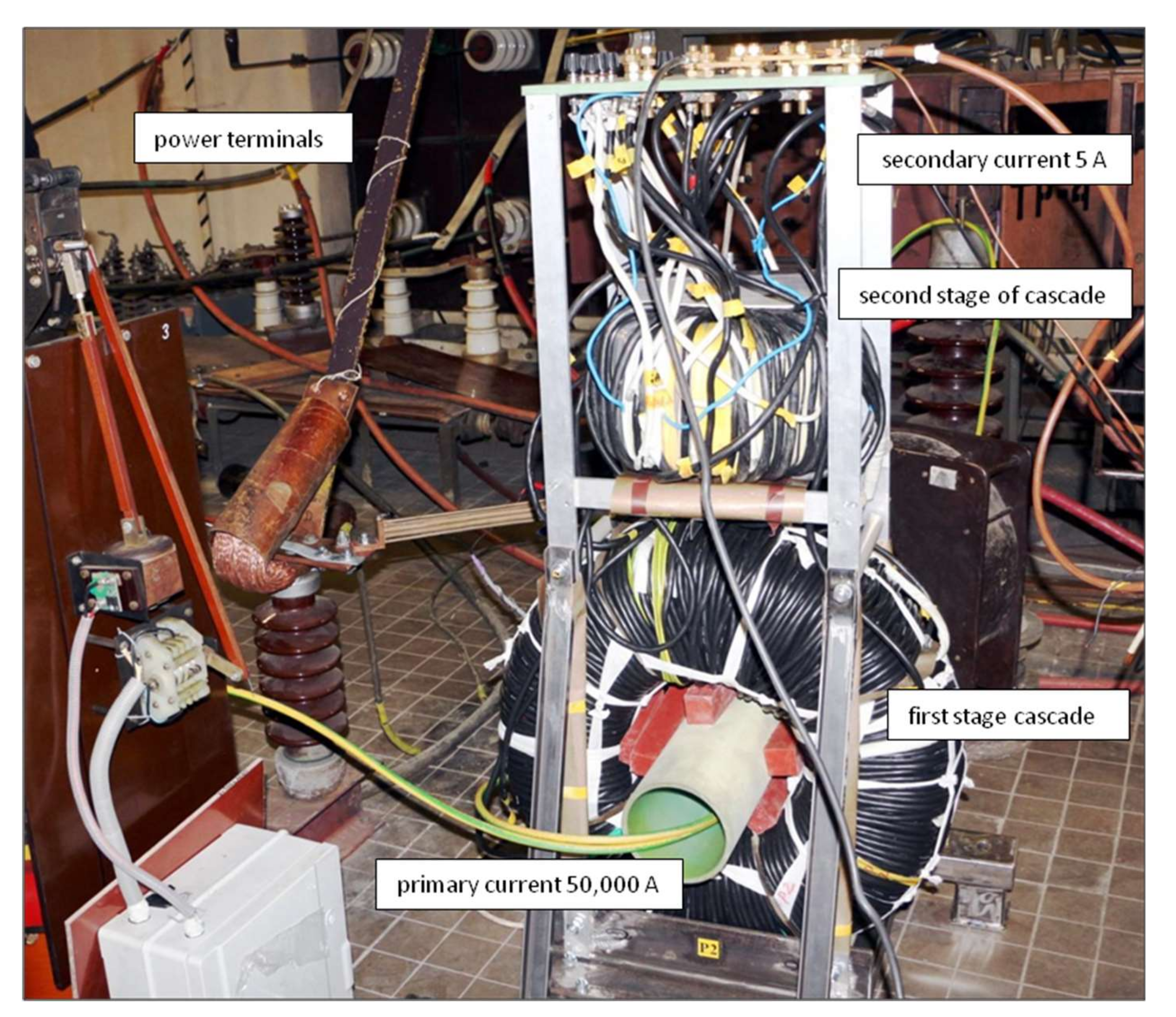
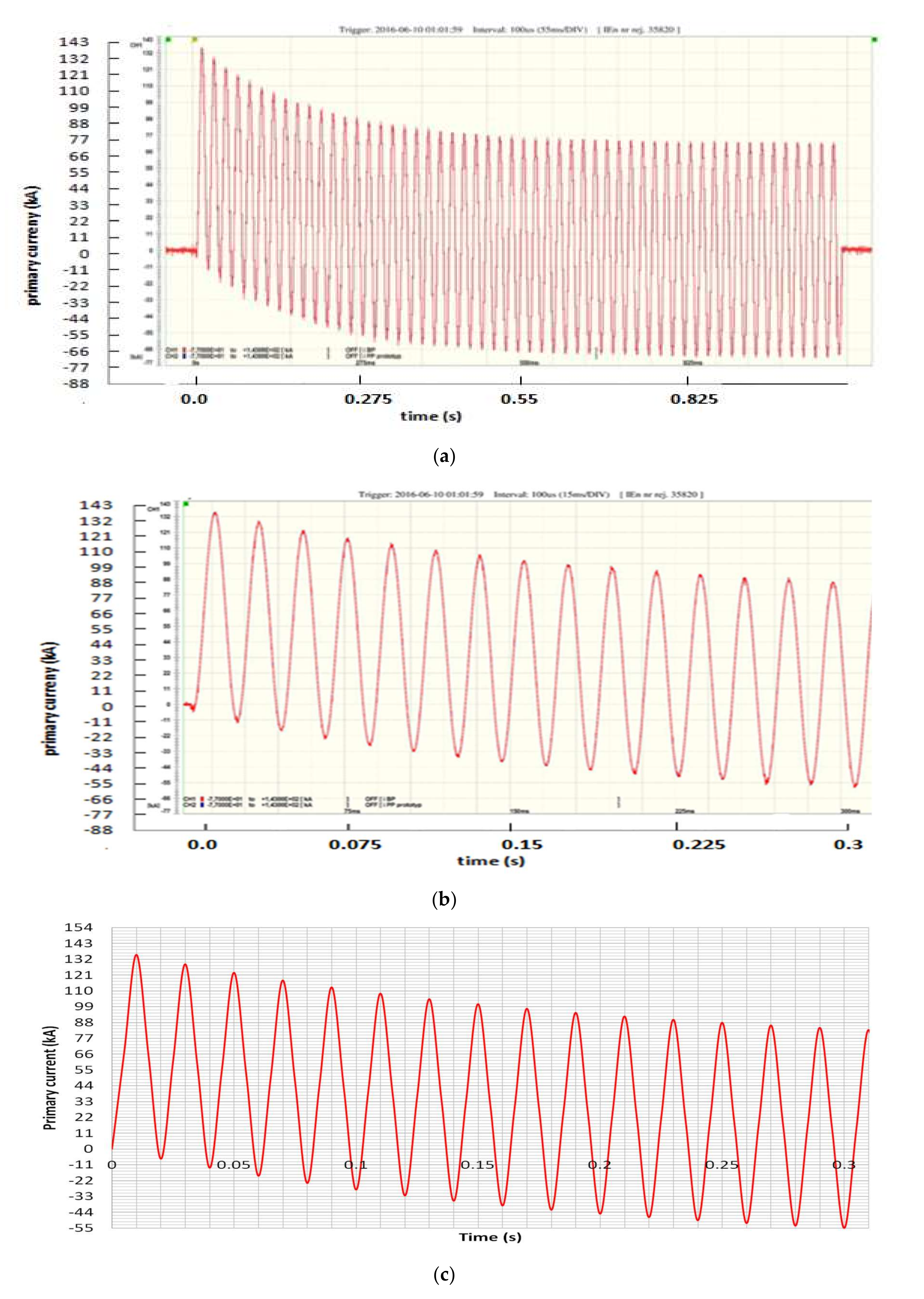
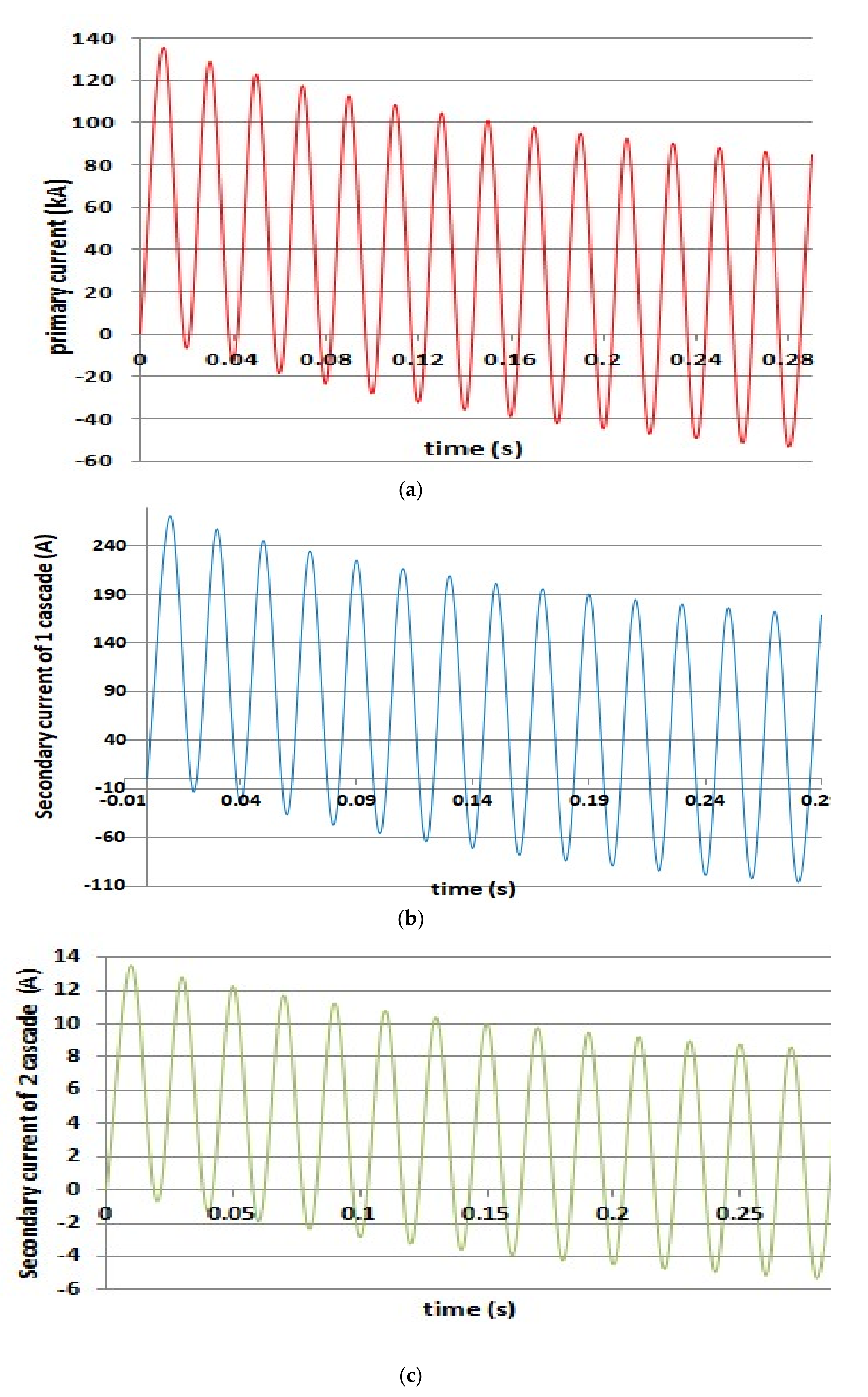
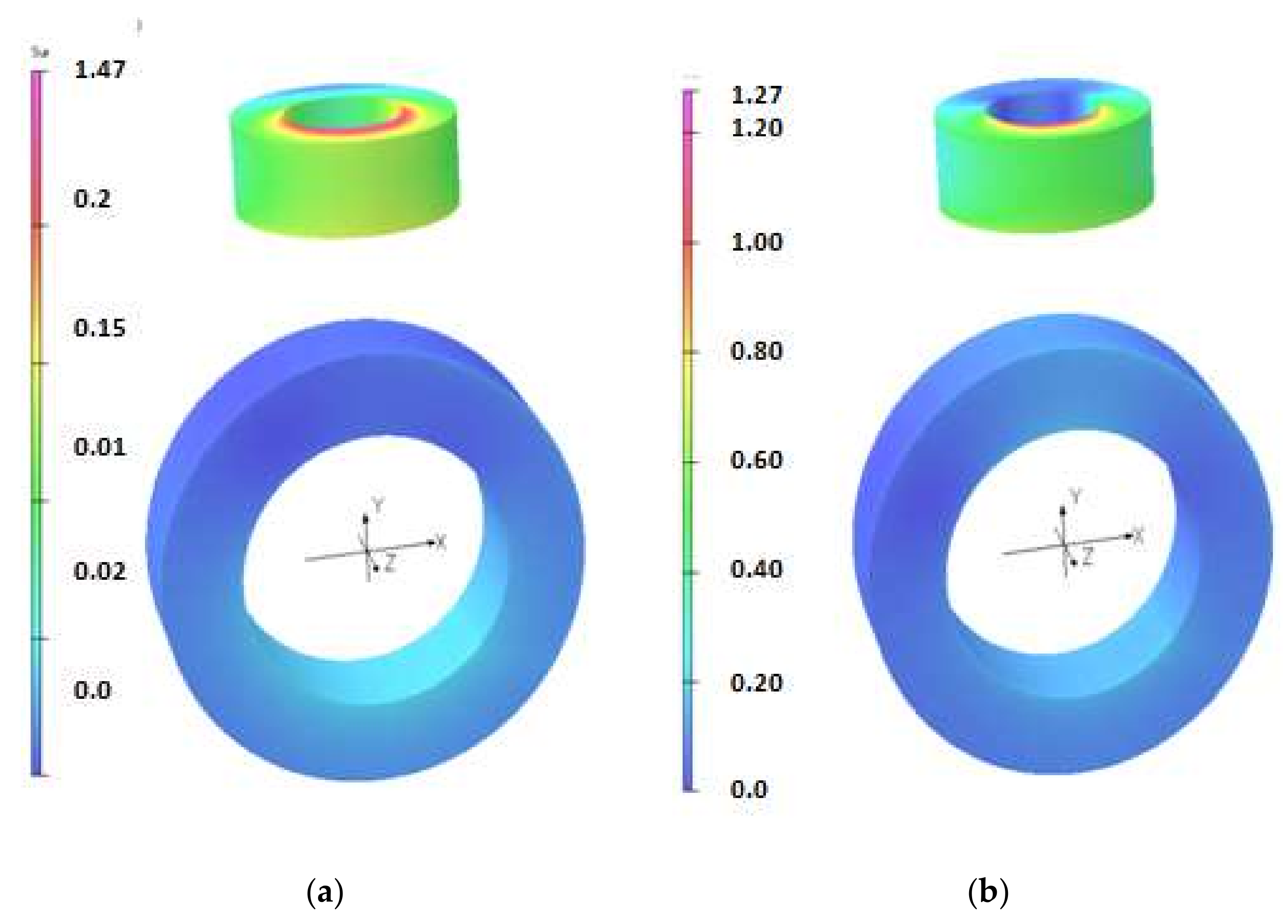

| Current Error (±%) | Phase Displacement (±min) | |||||||
|---|---|---|---|---|---|---|---|---|
| (%) Ipn | 5 | 20 | 100 | 120 | 5 | 20 | 100 | 120 |
| class limit 0.2 | ±0.75 | ±0.35 | ±0.2 | ±0.2 | ±30 | ±15 | ±10 | ±10 |
| computations | −0.113 | −0.113 | −0.08 | −0.084 | +5.2 | +5.2 | +4. 4 | +4.2 |
| Test | −0.016 | −0.021 | −0.010 | −0.012 | +9.0 | +3.5 | +1.1 | +1.0 |
| Instantaneous Peak Errors at Selected Peaks No. [%]: | |||||
|---|---|---|---|---|---|
| peaks no. | 1 | 2 | 5 | 10 | 15 |
| Computations | 0.11 | 0.22 | 0.29 | 0.21 | 0.42 |
| Test | 0.05 | 0.18 | 0.72 | 0.35 | 0.45 |
Publisher’s Note: MDPI stays neutral with regard to jurisdictional claims in published maps and institutional affiliations. |
© 2022 by the authors. Licensee MDPI, Basel, Switzerland. This article is an open access article distributed under the terms and conditions of the Creative Commons Attribution (CC BY) license (https://creativecommons.org/licenses/by/4.0/).
Share and Cite
Lesniewska, E.; Olak, J. Analysis of the Operation of Cascade Current Transformers for Measurements of Short-Circuit Currents with a Non-Periodic Component with a Large Time Constant of Its Decay. Energies 2022, 15, 2925. https://doi.org/10.3390/en15082925
Lesniewska E, Olak J. Analysis of the Operation of Cascade Current Transformers for Measurements of Short-Circuit Currents with a Non-Periodic Component with a Large Time Constant of Its Decay. Energies. 2022; 15(8):2925. https://doi.org/10.3390/en15082925
Chicago/Turabian StyleLesniewska, Elzbieta, and Jan Olak. 2022. "Analysis of the Operation of Cascade Current Transformers for Measurements of Short-Circuit Currents with a Non-Periodic Component with a Large Time Constant of Its Decay" Energies 15, no. 8: 2925. https://doi.org/10.3390/en15082925
APA StyleLesniewska, E., & Olak, J. (2022). Analysis of the Operation of Cascade Current Transformers for Measurements of Short-Circuit Currents with a Non-Periodic Component with a Large Time Constant of Its Decay. Energies, 15(8), 2925. https://doi.org/10.3390/en15082925







